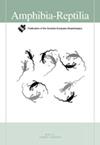圣帕特里克,无腿蜥蜴怎么办?追溯爱尔兰 Anguis(有鳞目:Anguidae)种群的线粒体归属和可能起源
IF 1
4区 生物学
Q3 ZOOLOGY
引用次数: 0
摘要
爱尔兰只有一种本地蜥蜴--胎生蜥蜴,也是世界上少数几个没有本地蛇类的地区之一。然而,自 19 世纪末以来,有报告称爱尔兰出现了无腿蜥蜴,即 Anguis fragilis Linnaeus, 1758 种,其来源不明。在过去的十年中,人们对该属动物进行了深入的遗传学和分类学研究,因此我们决定研究新近获得的 mtDNA 序列(ND2 基因),以追踪爱尔兰 Anguis 种群的隶属关系。我们对布伦地区(爱尔兰西部)的 12 个个体进行了基因检测,并与现有数据进行了比较。经鉴定,爱尔兰人属于 A. fragilis,特别是属于伊利里亚-中欧单倍群中最常见的单倍型。这一基因归属在广泛的欧洲地区都有,包括巴尔干半岛西部、西班牙、法国、匈牙利西部、奥地利、德国、拉脱维亚、波兰、捷克共和国、俄罗斯、瑞典、挪威和英国。我们的研究结果表明,爱尔兰人并没有表现出独特的线粒体变异性。这种单倍型存在于包括英国在内的整个物种分布区,这与之前的假设并不一致,即来自该地区的附近种群以及人类媒介的引入可能是爱尔兰安圭斯种群的来源。因此,这可能是第一个有记录的将 Anguis 引入原生地之外的案例。不过,要确定和追踪其确切的来源,还需要进一步的研究,包括在大不列颠进行更广泛的取样和基因组学研究。本文章由计算机程序翻译,如有差异,请以英文原文为准。
Saint Patrick, what about legless lizards? Tracing the mitochondrial affiliation and possible origin of Anguis (Squamata: Anguidae) population in Ireland
Ireland is home to only one native lizards’ species, the viviparous lizard and one of the few areas of the world where there are no native snakes. However, since the end of the 19th century, there have been reports indicating the presence of legless lizards, Anguis fragilis Linnaeus, 1758 population whose origin is unknown. As this genus has been intensively studied genetically and taxonomically in the past decade, we have decided to investigate newly obtained mtDNA sequences (ND2 gene) to trace affiliation of the Anguis population in Ireland. We genetically examined 12 individuals from the Burren area (western Ireland) and compared them to available data. The Irish population was identified as belonging to A. fragilis, specifically to the most common haplotype of the Illyrian-Central European haplogroup. This genetic affiliation is shared by populations across a wide European region, including the western Balkans, Spain, France, western Hungary, Austria, Germany, Latvia, Poland, the Czech Republic, Russia, Sweden, Norway, and Great Britain. Our findings showed that the Irish population does not exhibit unique mitochondrial variability. This haplotype is present across the range of the species, including Great Britain, which is not in contrast with the earlier hypothesis that nearby populations from this area, along with human-mediated introductions, could be the source of Anguis populations in Ireland. This is thus potentially the first documented case of Anguis introduction out of the native range. However, further research, including broader sampling in Great Britain and genomics, is required to determine and trace its exact origin.
求助全文
通过发布文献求助,成功后即可免费获取论文全文。
去求助
来源期刊

Amphibia-Reptilia
生物-动物学
CiteScore
3.10
自引率
6.20%
发文量
39
审稿时长
6-12 weeks
期刊介绍:
Amphibia-Reptilia is a leading European multi-disciplinary journal devoted to most of the aspects of herpetology: ecology, behaviour, evolution, conservation, physiology, morphology, paleontology, genetics, and systematics.
Amphibia-Reptilia publishes high quality original papers, short-notes, reviews, book reviews and news of the Societas Europaea Herpetologica (SEH). The Societas Europaea Herpteologica (SEH) website is located at: www.seh-herpetology.org.
 求助内容:
求助内容: 应助结果提醒方式:
应助结果提醒方式:


